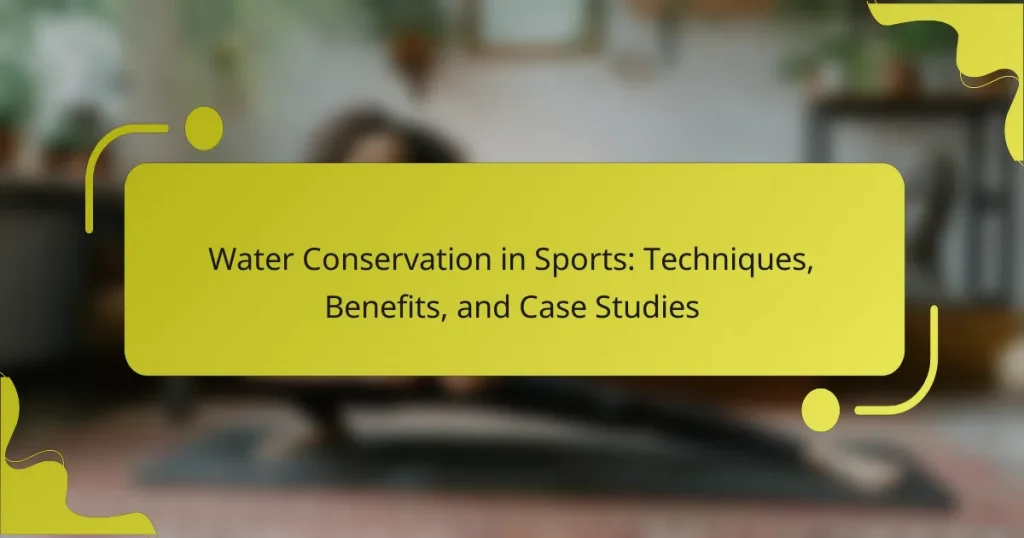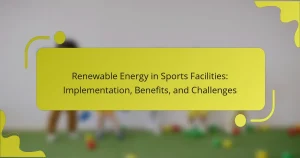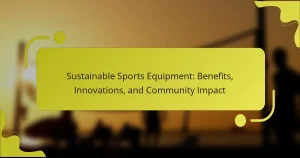Water conservation in sports is essential for sustainability and cost reduction. This article explores effective techniques such as rainwater harvesting and efficient irrigation systems, highlights the benefits for organizations, and presents case studies showcasing successful implementations. Understanding these strategies can enhance environmental responsibility and operational efficiency in sports facilities.
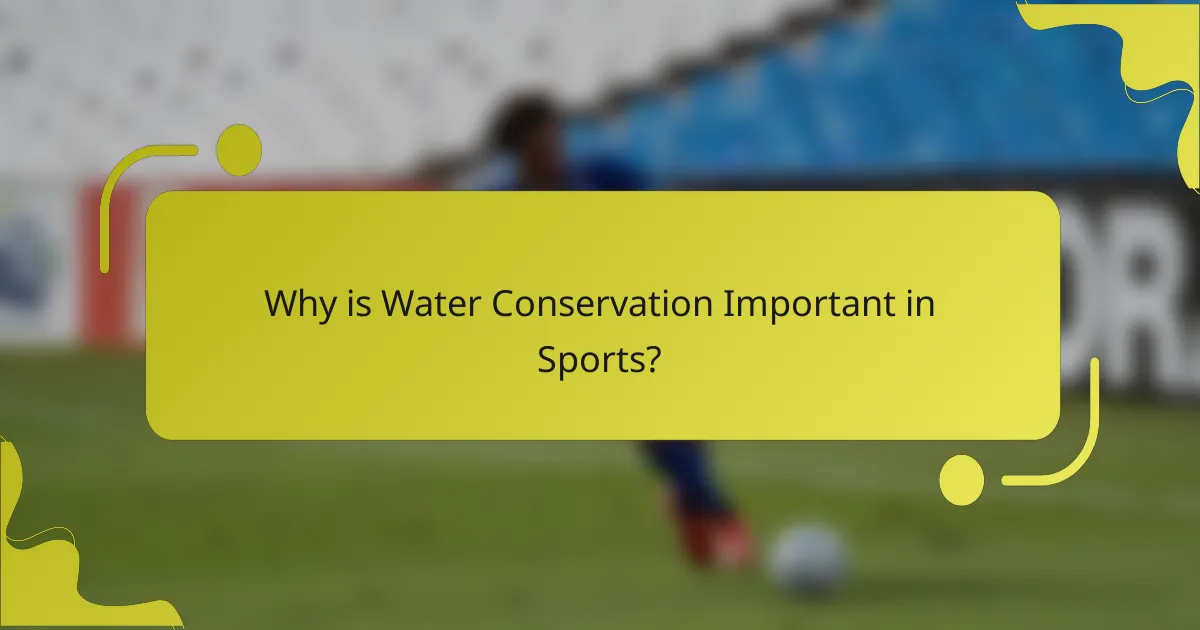
Why is Water Conservation Important in Sports?
Water conservation is crucial in sports to ensure sustainable practices and resource management. It helps maintain facilities, supports athlete hydration, and reduces operational costs. Effective techniques include rainwater harvesting, efficient irrigation systems, and water recycling. These methods not only preserve water but also enhance environmental responsibility in sports organizations. Case studies show successful implementations, like the use of drought-resistant landscaping in stadiums, which significantly cut water usage while maintaining aesthetic appeal.
What are the Environmental Impacts of Sports on Water Resources?
Water-intensive sports can negatively impact water resources through increased consumption and pollution. Techniques for water conservation in sports include rainwater harvesting, efficient irrigation systems, and using drought-resistant landscaping. These methods not only reduce water usage but also enhance sustainability. Case studies show facilities implementing these techniques experience significant water savings, promoting environmental stewardship in sports.
How Does Water Conservation Enhance Sustainability in Sports?
Water conservation enhances sustainability in sports by reducing resource consumption and promoting eco-friendly practices. Effective techniques include rainwater harvesting, efficient irrigation systems, and water recycling. These methods not only lower costs but also minimize environmental impact. Case studies show that facilities adopting these practices significantly reduce water usage, contributing to overall sustainability goals in the sports industry.

What Techniques are Effective for Water Conservation in Sports?
Effective techniques for water conservation in sports include implementing rainwater harvesting, using efficient irrigation systems, promoting drought-resistant landscaping, and encouraging water-saving practices among athletes and staff. These methods not only reduce water waste but also enhance sustainability in sports facilities. For example, rainwater harvesting can capture and reuse water for irrigation, while efficient irrigation systems minimize runoff. As a result, these practices contribute to significant water savings and promote environmental stewardship in the sports community.
Which Technologies are Transforming Water Management in Athletic Facilities?
Innovative technologies are significantly enhancing water management in athletic facilities. Smart irrigation systems optimize water usage by adjusting to weather conditions, reducing waste. Water recycling systems reclaim greywater for non-potable uses, promoting sustainability. Advanced monitoring tools track water consumption, enabling facilities to identify leaks and inefficiencies. These technologies contribute to overall water conservation, benefiting both the environment and operational costs.
How Can Teams Implement Water-Saving Practices During Events?
Teams can implement water-saving practices during events by adopting specific strategies. These include using water-efficient fixtures, recycling water for irrigation, and educating attendees on conservation methods.
Utilizing smart irrigation systems can reduce water waste significantly. For example, these systems adjust watering schedules based on weather conditions, ensuring optimal water use.
Encouraging attendees to use refillable water bottles helps minimize single-use plastic and reduces overall water consumption. Providing easily accessible water stations promotes this practice.
Case studies show that events implementing these techniques can achieve up to a 30% reduction in water usage. This not only benefits the environment but also reduces operational costs for organizers.
What Role Does Education Play in Promoting Water Conservation Among Athletes?
Education plays a crucial role in promoting water conservation among athletes by raising awareness and providing practical strategies. It informs athletes about the environmental impact of water usage and encourages responsible consumption practices. For example, educational programs can teach athletes to monitor their water intake, use water-efficient training techniques, and adopt sustainable practices during events. As a result, athletes become advocates for conservation, influencing their peers and communities. Engaging educational initiatives not only foster individual responsibility but also contribute to broader environmental sustainability in sports.
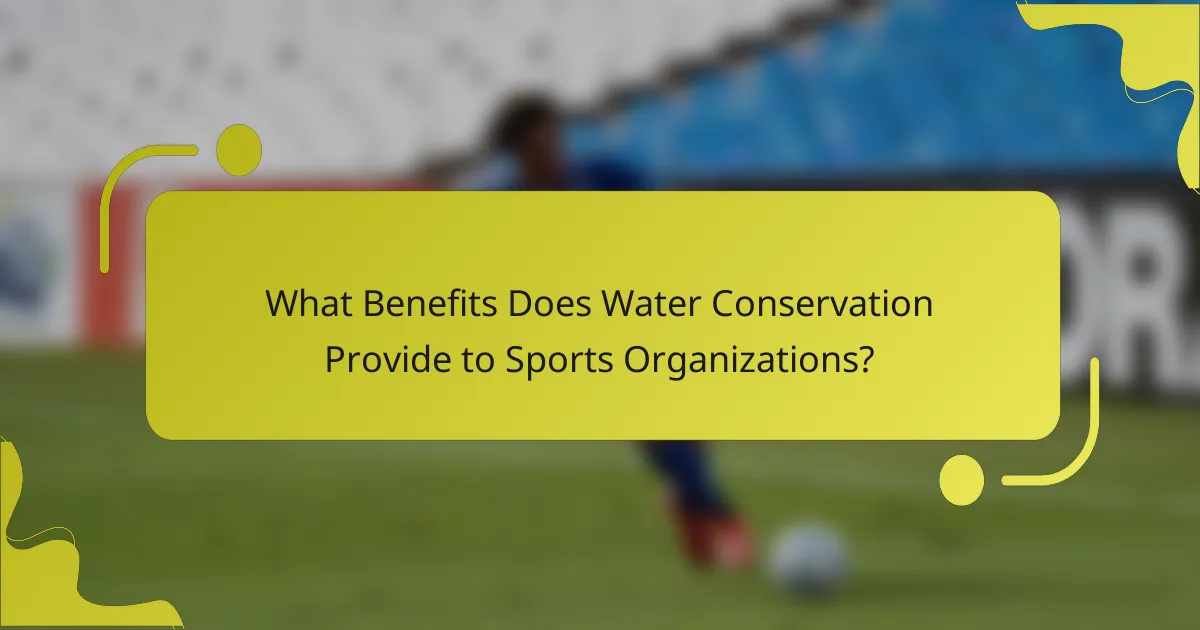
What Benefits Does Water Conservation Provide to Sports Organizations?
Water conservation provides significant benefits to sports organizations, including cost savings and enhanced sustainability. By implementing water-saving techniques, organizations can reduce operational expenses related to water usage. This practice also helps improve their public image, attracting environmentally conscious fans and sponsors. Additionally, water conservation contributes to ecological preservation, ensuring that natural resources remain available for future generations. As a result, sports organizations that prioritize water conservation can achieve both financial and reputational advantages while promoting responsible resource management.
How Can Water Conservation Lead to Cost Savings for Sports Facilities?
Water conservation can significantly reduce operational costs for sports facilities. Implementing efficient irrigation systems, rainwater harvesting, and water recycling can lower utility bills and maintenance expenses. For example, facilities that adopt smart irrigation technology can save up to 50% on water usage. Additionally, reducing water waste enhances sustainability, attracting eco-conscious sponsors and fans. Case studies show that facilities investing in water-saving technologies often see a return on investment within a few years.
What are the Health Benefits of Reducing Water Waste in Sports?
Reducing water waste in sports leads to significant health benefits for athletes and communities. Efficient water use promotes better hydration, reduces the risk of heat-related illnesses, and encourages sustainable practices that enhance overall well-being.
Enhanced hydration ensures athletes maintain peak performance, while sustainable practices contribute to environmental health. For example, sports organizations that implement water conservation techniques often see a reduction in operational costs and increased community support.
In addition, adopting water-efficient technologies can improve the quality of facilities, resulting in healthier training environments. This approach not only benefits athletes but also fosters a culture of responsibility towards natural resources.
Overall, reducing water waste in sports creates a positive impact on health, enhances performance, and promotes sustainability within communities.

Which Case Studies Highlight Successful Water Conservation in Sports?
Several case studies demonstrate successful water conservation in sports, showcasing innovative techniques and significant benefits.
The Arizona State University Sun Devil Athletics implemented a rainwater harvesting system, capturing over 200,000 gallons annually. This initiative reduced water usage by 30% across their facilities.
In the UK, the Wimbledon Tennis Championships adopted a water recycling system, treating and reusing water for irrigation. This approach has saved approximately 1 million liters of water each year.
The San Francisco Giants’ Oracle Park features a state-of-the-art irrigation system that adjusts based on weather conditions. This system has led to a 50% reduction in water consumption for landscaping.
Lastly, the Seattle Seahawks focus on sustainable practices at Lumen Field, using permeable paving and rain gardens to manage stormwater effectively, enhancing local water quality while conserving resources.
What Lessons Can Be Learned from Major Sports Events Implementing Water Conservation?
Major sports events can teach valuable lessons in water conservation through innovative techniques and successful case studies. Events like the FIFA World Cup and the Olympics have implemented strategies such as rainwater harvesting and drought-resistant landscaping. These initiatives not only reduce water usage but also promote sustainability among athletes and fans. For instance, the 2016 Rio Olympics showcased a water recycling system that saved millions of liters. As a result, sports organizations can inspire communities to adopt similar practices, enhancing awareness and commitment to water conservation.
How Have Professional Teams Achieved Water Efficiency Goals?
Professional teams have achieved water efficiency goals through innovative technologies and sustainable practices. Techniques such as rainwater harvesting, smart irrigation systems, and water recycling have been implemented to minimize consumption. For example, Major League Baseball teams have adopted advanced irrigation management systems that reduce water use by up to 30%. Additionally, the use of drought-resistant landscaping has enhanced conservation efforts. These strategies not only lower operational costs but also promote environmental responsibility within the sports industry.
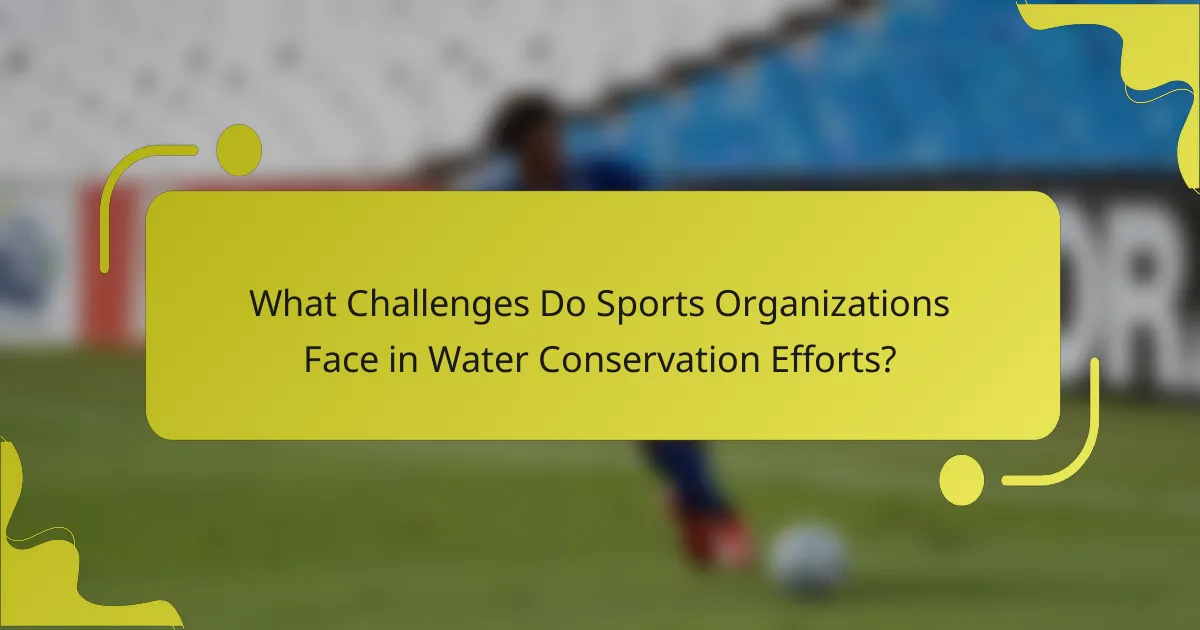
What Challenges Do Sports Organizations Face in Water Conservation Efforts?
Sports organizations face significant challenges in water conservation efforts, including funding limitations, infrastructure constraints, and stakeholder engagement. Funding for sustainable initiatives often competes with other priorities, limiting investment in water-saving technologies. Many facilities have outdated plumbing and irrigation systems, which are inefficient and costly to upgrade. Additionally, engaging fans and local communities in conservation efforts can be difficult, as awareness and participation levels vary. As a result, organizations must innovate and collaborate to overcome these barriers and promote effective water conservation practices.
How Do Regulatory Requirements Impact Water Use in Sports?
Regulatory requirements significantly influence water use in sports by mandating conservation practices. Compliance with these regulations often drives the adoption of water-efficient technologies and sustainable management strategies. For instance, sports facilities may implement rainwater harvesting systems to meet legal standards while reducing overall water consumption. Additionally, regulations can promote awareness and education about water conservation among athletes and staff, fostering a culture of sustainability within sports organizations. As a result, adherence to these requirements not only ensures legal compliance but also enhances the environmental responsibility of sports entities.
What Common Misconceptions Exist About Water Conservation in Sports?
Many misconceptions exist about water conservation in sports, primarily around its necessity and effectiveness. Some believe that conserving water is irrelevant in high-performance sports. In reality, efficient water use can significantly enhance athletes’ performance and sustainability efforts. Another common myth is that water conservation measures compromise training quality. However, innovative techniques can maintain, or even improve, training conditions while reducing water usage. Additionally, some think that only elite sports organizations need to prioritize water conservation. In truth, all levels of sports can benefit from sustainable practices, contributing to broader environmental goals.
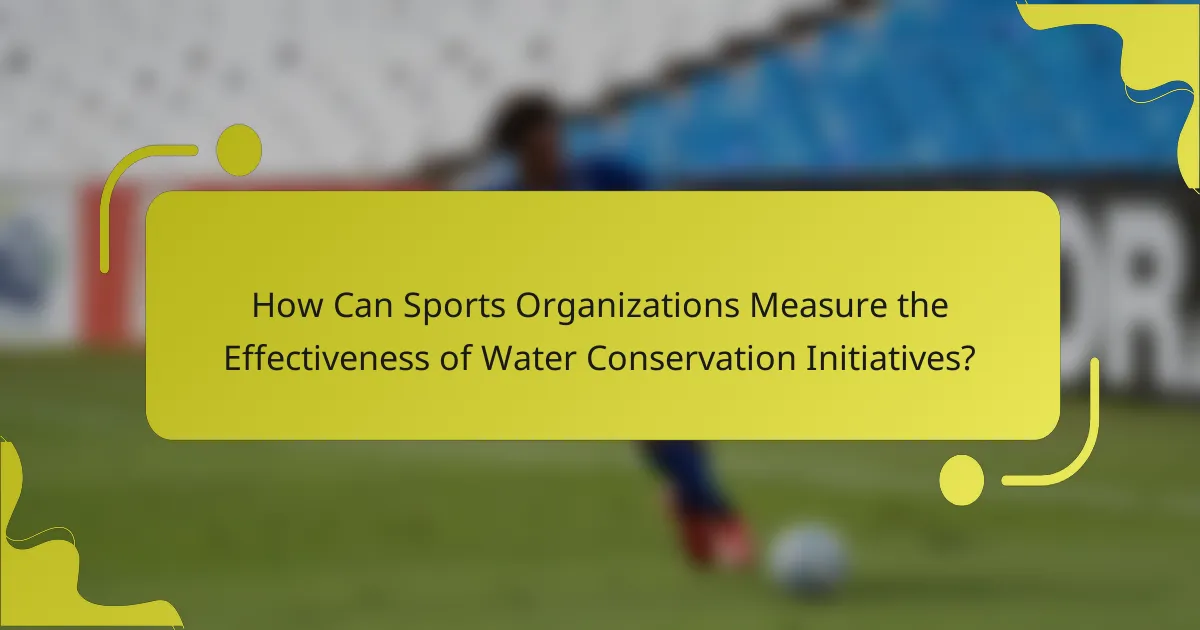
How Can Sports Organizations Measure the Effectiveness of Water Conservation Initiatives?
Sports organizations can measure the effectiveness of water conservation initiatives through metrics like water usage reduction, cost savings, and community engagement. Tracking these factors provides insights into the impact of implemented strategies. For instance, a sports facility may compare water consumption before and after conservation measures. Surveys can assess community awareness and support for these initiatives. Additionally, case studies showcasing successful water-saving practices can serve as benchmarks for future efforts.
What Metrics Should Be Used to Assess Water Usage in Sports Facilities?
To assess water usage in sports facilities, track metrics like total water consumption, irrigation efficiency, and water recycling rates. These metrics provide insights into water conservation efforts and identify areas for improvement.
| Metric | Description | Value Example |
|——————————-|——————————————–|————————|
| Total Water Consumption | Overall water usage in a facility | 100,000 gallons/month |
| Irrigation Efficiency | Ratio of water used to water absorbed by plants | 75% |
| Water Recycling Rates | Percentage of water reused | 30% |
| Fixture Flow Rates | Water flow rate of fixtures | 1.5 gallons/minute |
| Rainwater Harvesting Volume | Amount of rainwater collected | 5,000 gallons/year |
| Staff Training Participation | Percentage of staff trained in water conservation | 80% |
How Can Data Analytics Enhance Water Conservation Strategies in Sports?
Data analytics can significantly enhance water conservation strategies in sports by providing actionable insights. By analyzing consumption patterns, organizations can identify inefficiencies and optimize water usage.
For example, predictive analytics can forecast water needs based on weather patterns and event schedules. This data-driven approach allows for more efficient irrigation of fields, reducing waste.
Additionally, real-time monitoring systems can track water usage in facilities, enabling immediate adjustments. This proactive management helps in minimizing water waste during events and training sessions.
Case studies show that sports teams implementing these analytics have achieved up to 30% reductions in water usage, demonstrating the effectiveness of data-driven strategies in promoting sustainability.
What Best Practices Should Sports Organizations Follow to Optimize Water Conservation?
Sports organizations should implement best practices such as rainwater harvesting, efficient irrigation systems, and drought-resistant landscaping to optimize water conservation. These techniques reduce water usage and enhance sustainability.
1. Assess water usage to identify areas for improvement.
2. Install smart irrigation technology to minimize waste.
3. Promote water conservation awareness among staff and athletes.
4. Utilize native plants for landscaping to reduce irrigation needs.
5. Implement rainwater collection systems for irrigation and facility use.
6. Monitor water consumption regularly to track progress.
